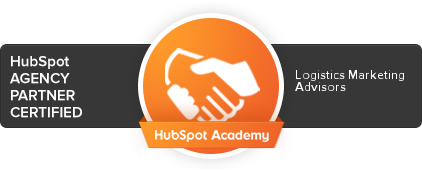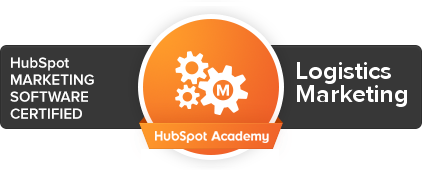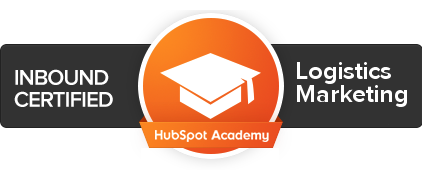I just returned from the excellent Transportation Sales and Marketing Conference in Ft. Lauderdale. One of the major themes on the minds of attendees was using technology to manage the marketing and sales process.
It’s a real pain point for folks and I was amazed to learn that many companies, some with over a billion dollars in revenue, don’t even have a CRM.
Companies balk at the price tag for some marketing automation systems. We are a HubSpot-certified partner and I am the first one to admit that the tool isn’t cheap. You’ll probably pay over $10,000 per year to get all the functionality you want.
Looked at solely as an expense, many logistics companies dismiss such costs as budget-busting. But a Hubspot ROI, or Pardot or Eloqua, must be viewed as an investment that contributes to a larger pipeline and superior sales results.
Specifically, you need to weigh marketing automation software costs against the value of time and how that time can contribute to meeting your ultimate sales and marketing objectives.
Two holes, two approaches
 Let’s say, instead of building a sophisticated inbound marketing program, your challenge is digging a hole. So you ask the boss for the $50 HubSpot shovel. His reaction: “What, $50 for a shovel?! Here’s a hand shovel I use in my garden and it’s free. Can you dig the hole with this?”
Let’s say, instead of building a sophisticated inbound marketing program, your challenge is digging a hole. So you ask the boss for the $50 HubSpot shovel. His reaction: “What, $50 for a shovel?! Here’s a hand shovel I use in my garden and it’s free. Can you dig the hole with this?”
Well, you can and you do. But it takes three hours, instead of one.
Once the hole is done, the boss admires the excellent result. It appears that his frugal approach made sense since the hole looks as good as any one dug with a HubSpot shovel.
The problem is he didn’t just save $50, he lost hundreds of dollars in productivity because it took three times longer to dig the hole. What could you have accomplished with that extra time?
Digging real-world holes
The other day, for a new client, we experienced a glitch in using MailChimp for an automated email that would point to a blog on a WordPress site. Our crack technology guy spent a few hours troubleshooting the issue of how MailChimp formats emails generated by RSS feeds - already a headache. We then switched over to the client’s Act-On tool and spent time formatting the email there. It tested well but then Act-On misbehaved (empty emails were sent out) and no immediate support was available. So we switched back to MailChimp and lost another few hours – all for a simple email to a blog subscriber list.
With every new client, there is some figuring out that needs to be done. But still, this kind of hiccup is costly and exasperating.
The value of HubSpot is that it’s an all-in-one tool. Once you learn it, you can accomplish many of the tasks marketers need to do in one tool – emailing, landing page creation, blogging, call-to-action buttons, campaigns, lead scoring, etc. No bouncing around from one tool to another and trolling support websites looking for answers when problems surface. A 24/7 support line is available to answer questions almost immediately.
Of course you pay for this convenience. But you recoup the investment in time savings and uninterrupted focus. Check out this blog post on Hubspot ROI, called Frankenspot, which looks at what it would take to duplicate HubSpot functionality in a WordPress environment. Here is another link that compares Wordpress and HubSpot environments.
Logistics systems and the value of uniformity
Let’s look at our own warehouse and transportation operations. How many 3PL warehouse operators in a multi-client facility want to use a different WMS for each customer’s work?
No, they prefer to use one system with uniform processes for receiving, putaway, picking, etc. Once you add multiple systems, it has cost implications for:
- Extra training
- Error corrections
- Lost productivity
- Duplicate SOP documentation
Same with transportation systems. You want to train people to rate, route and optimize shipments on your system of choice, not multiple systems. Easy is good.
So why, when it comes to marketing and sales automation tools, should our attitude suddenly shift. Why aren’t uniform systems that promote consistency and save time the de facto choice?
HubSpot ROI: the Cost Comparison
To get the functionality you want on a HubSpot platform will run you $10,000+ per year. Using a mix of WordPress plug-ins (easily a dozen or more, which will require regular updates) and other software tools, you can come close to duplicating HubSpot’s functionality and do it for just hundreds of dollars a year.
Choosing between these two options, it’s an easy decision for a purchasing manager looking ONLY at the expense line. But as an executive who is building a growth engine for your company, you must consider the value of time, for both your own people and the consultants you hire to help build and manage this growth engine.
Closing the loop completely
In 2014, HubSpot introduced a basic CRM to complement its marketing automation tool. This rounds out a system that can now support an easy-to-track, closed loop marketing and sales process.
The HubSpot CRM is not for Salesforce.com power users; it’s not nearly as robust a CRM and pipeline management tool. But it’s fine for many companies – including Salesforce users who are using only a small fraction of the tool’s functionality.
HubSpot is catching on in the logistics space. We’ve talked with about 10 companies who use the tool and none have regretted the investment.
Granted, HubSpot is not a minor expense. But it is a relatively minor investment if it helps in achieving a multi-million dollar new business goal.
Learn more about Logistics Marketing Advisors Magnet Marketing approach to selling logistics services (Download PDF).







